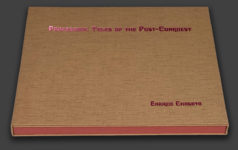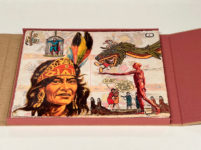
layered acrylic ink and varnish on amate paper
10 x 94 inches
edition of 12
Enrique Chagoya’s 2021 codex editions with Magnolia Editions take the artist’s signature collage technique — what he describes as “a hybrid contemporary genesis narrating multiple cultural collisions” — to kaleidoscopic new heights. Printed on traditional amate paper using layered UV-cured ink, Chagoya’s codices bring an iconoclastic and highly comic approach to historical narratives of colonialism and conquest — and to the ponderous critical theory that often sandbags our understanding of complex events, imagery, and ideas. As Patricia Hickson has written of Chagoya’s codices: “These nuanced, imaginary adventures with a social conscience could exist only in the space of a dream.”
Chagoya’s Procession/Tales of the Post-Conquest (2021) draws its background elements from a codex (now held in the Vatican) originating from Oaxaca, where Mixtec and Zapotec civilizations lived until being conquered by the Aztecs approximately thirty years before the Spanish arrived. Nearly all such pre-Columbian books were burnt by a single Spanish priest in the 1500s. Besides the four Mayan books in Madrid, Dresden, Paris and Mexico City, only 19 books survived from the Mixtec-Zapotec areas in Oaxaca; they are now held in European libraries and museums. In keeping with the spirit of Chagoya’s previous codices, the work’s “pseudo-pre-Columbian affect and quixotic content [are] strategic, suggesting a ‘lost document’ from a parallel universe” (Sarah Kirk Hanley) in which the great Meso-American libraries had survived and the Aztecs had proceeded to conquer Europe.
Cheerfully refusing to take its time-traveling cornucopia of colorful characters — many drawn from the artist’s own collection of vintage Mexican comics — too seriously, Chagoya’s codex also incorporates snatches of solemn and impossibly overwrought phrases borrowed from actual art criticism, known in the business as ‘art-speak.’ Their impenetrability and sheer absence of meaning preemptively lampoon any reductive or static reading of the artist’s inherently multivalent and dynamic imagery. “Ultimately,” says Chagoya, “it’s about humor — I hope people will see themselves in the mirror.”
-Nick Stone
show prices
Prices and availability are subject to change without notice.The copyright of all art images belongs to the individual artists and Magnolia Editions, Inc.
©2003-2025 Magnolia Editions, Inc. All rights reserved. contact us



